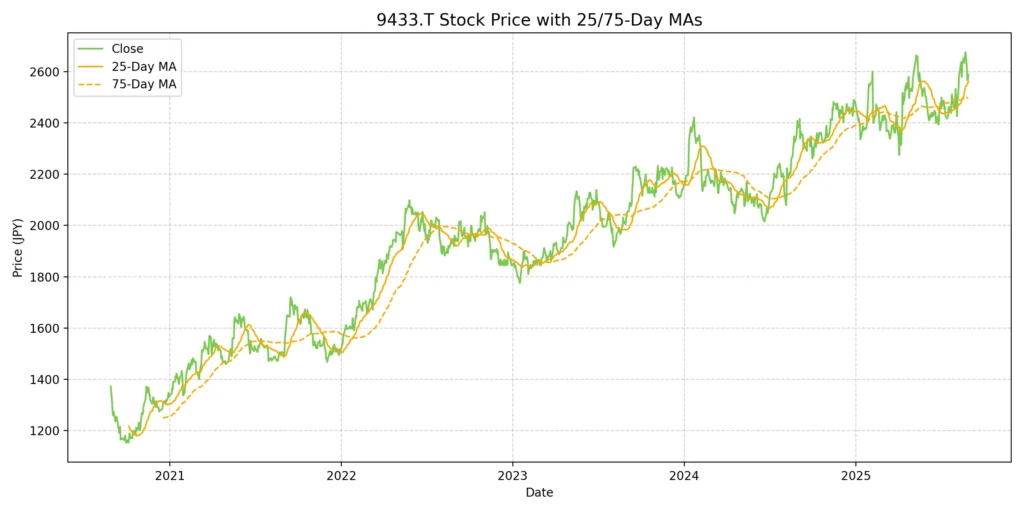KDDI CORPORATION (TSE: 9433): Stock Analysis
August 31, 2025

1. Introduction
KDDI Corporation (TSE: 9433) is one of Japan’s three major telecommunications operators, competing with NTT Docomo and SoftBank. Through its “au,” “UQ mobile,” and “povo” brands, KDDI serves roughly 65 million subscribers nationwide. In addition to mobile services, the company has expanded into broadband, fintech, energy, and digital solutions, steadily evolving from a telecom carrier into a diversified service provider.
For investors, KDDI represents a hybrid investment case: the core telecom business provides stability and high recurring cash flows, while new business domains create growth optionality. Understanding how KDDI balances these two dimensions is key to assessing whether its stock can continue to rise.
2. Stock-Price Development & Valuation Snapshot
As of August 29, 2025, KDDI’s stock closed at JPY 2,550.5, slightly below its year-to-date high of JPY 2,692 (Aug 22). The 52-week range stands at JPY 2,227–2,692, reflecting steady appreciation and relatively low volatility compared to the broader TOPIX.
At the current share price:
PER: ~15.1× (FY2025 EPS ¥169.3)
PBR: ~2.0× (BPS ¥1,288.96)
Dividend yield: ~2.8% (DPS ¥72.5)
ROE: ~13.3%
Valuation sits in a balanced zone—neither bargain nor bubble—supported by consistent earnings, stable ROE, and a growing dividend.
3. Financial Performance & Ratio Trends
KDDI’s financial results over the past three years highlight resilience in a mature domestic market:
| Fiscal Year | Revenue (¥ bn) | Operating Profit (¥ bn) | Net Profit (¥ bn) | EPS (¥) | DPS (¥) | ROE (%) |
|---|---|---|---|---|---|---|
| FY2023/3 | 5,672 | 1,076 | 677 | 155.1 | 67.5 | 13.4 |
| FY2024/3 | 5,754 | 962 | 638 | 150.6 | 70.0 | 13.9 |
| FY2025/3 | 5,918 | 1,119 | 686 | 169.3 | 72.5 | 13.3 |
Analysis:
Revenue grew modestly (+4% over three years), reflecting both the maturity of Japan’s telecom market and incremental contributions from non-telecom businesses.
Operating profit remained robust, with margins above 18%, demonstrating strong cost control despite pricing pressures.
Net profit reached ¥686 bn in FY2025, marking the company’s highest level to date.
EPS growth allowed steady dividend increases, supporting a shareholder-friendly profile with a payout ratio around 45–50%.
ROE stability at 13–14% is above the average for Japanese corporates, underscoring efficient capital allocation.
4. Business Segments & Strategic Positioning
KDDI’s business is built on two pillars:
Personal Services – Consumer-facing operations including mobile, broadband, energy, financial services, and digital content. The multi-brand approach (au, UQ, povo) enables KDDI to address both premium and value segments. Bundling with au PAY (a mobile payment and digital wallet service), digital banking, and energy services increases customer stickiness and lifetime value.
Business Services – Enterprise solutions spanning IoT, cloud, cybersecurity, and data centers under the global “Telehouse” brand. This segment benefits from rising demand for digital transformation (DX) in Japan and Asia, and provides KDDI with a non-consumer growth engine.
5. Strategic Framework: Satellite Growth Strategy
The fundamental question for investors—can KDDI’s stock continue to rise?—cannot be answered by telecom cash flows alone. Japan’s mobile market is saturated, ARPU (Average Revenue Per User) growth is capped, and regulatory pressure persists. What matters is whether KDDI has a credible growth strategy beyond traditional telecom. This is where the Satellite Growth Strategy becomes pivotal.
Core Principle
KDDI positions its telecom business as the cash-generating nucleus, around which new “satellite” businesses orbit. The aim is to transform KDDI from a pure telecom operator into a multi-service ecosystem company, capable of sustaining long-term earnings growth.
Orbit 1 – Near-Term Growth Engines
These businesses are already generating revenue and are expected to contribute meaningfully within the next 3–5 years.
Digital Transformation (DX)
KDDI leverages its network infrastructure, 5G connectivity, IoT platforms, and data centers (Telehouse) to support corporate digital transformation.
Demand is rising as Japanese enterprises modernize legacy IT systems and adopt cloud services.
For investors, this creates recurring B2B revenues, often with higher margins than consumer telecom.
Financial Services (au PAY, Banking, Insurance)
au PAY is KDDI’s mobile payment and digital wallet platform, with transaction volumes growing at double-digit rates.
Through cross-selling, KDDI links au PAY with au Jibun Bank, securities brokerage, and insurance products, expanding fee-based income.
This segment increases customer retention: telecom subscribers who use au PAY and au Jibun Bank are less likely to churn.
Energy Solutions (au Energy)
KDDI has entered Japan’s liberalized electricity market, offering bundled energy services alongside telecom contracts.
The focus is on retail electricity supply and renewable energy projects, aligning with Japan’s decarbonization agenda.
While still a smaller contributor, energy provides a hedge against telecom pricing pressure and strengthens KDDI’s household ecosystem.
Collectively, Orbit 1 businesses already contribute to profits and help offset the structural stagnation in mobile ARPU, thereby enhancing earnings visibility.
Orbit 2 – Longer-Term Growth Options
These initiatives are in earlier stages and represent growth optionality for the next 5–10 years.
Mobility
KDDI is developing connected-car solutions, integrating vehicle telematics with 5G networks.
Partnerships with automakers are focused on EV infrastructure and smart transportation systems.
Monetization will take time, but the mobility sector could open new recurring service revenues.
Healthcare
Leveraging IoT and secure connectivity, KDDI is piloting remote monitoring, wearable devices, and telemedicine platforms.
Japan’s aging population creates strong long-term demand for healthcare solutions that reduce hospital visits and improve preventive care.
Smart Cities
Using data from sensors, IoT, and 5G networks, KDDI is working on digital twins for urban planning and disaster resilience.
Potential customers include municipalities and infrastructure operators.
This plays into government-backed smart city initiatives, offering large-scale B2G opportunities.
Next-gen Technologies (Metaverse, Web3, AI)
KDDI is experimenting with immersive platforms (metaverse) and blockchain/Web3 applications to expand digital lifestyles.
AI integration into customer services and network optimization can both reduce costs and enable new offerings.
Though high-risk and early-stage, these initiatives show KDDI’s intent to stay relevant in future digital ecosystems.
Orbit 2 businesses will not materially impact short-term profits but offer strategic optionality. If even one area (e.g., healthcare or smart cities) scales, it could provide a significant long-term earnings driver.
Investor Takeaway
Risk Mitigation: Orbit 1 diversifies earnings away from telecom, reducing reliance on ARPU.
Earnings Visibility: Already-profitable businesses (fintech, energy, DX) enhance medium-term growth confidence.
Valuation Support: Successful execution in Orbit 1 could lead to multiple expansion, as markets reward diversification beyond telecom.
Upside Catalysts: Monetization of au PAY, acceleration in energy adoption, and increased DX/IoT demand are key near-term triggers. Orbit 2 offers long-term upside if new markets mature.
6. Investment Evaluation Points
Key points for investors include:
Defensive cash flows from telecom ensure stable earnings even under pricing pressure.
Dividend reliability: DPS has grown steadily (¥67.5 → ¥72.5 in three years).
Attractive ROE of ~13% versus Japan’s average ~8–9%.
Balanced valuation: PER ~15× is fair given the mix of defensive stability and growth optionality.
Diversification into fintech and energy creates resilience compared to peers overly dependent on mobile revenues.
7. Competitive Landscape: NTT Docomo and SoftBank
Japan’s telecom sector is characterized by an oligopoly of three carriers—NTT Docomo, KDDI, and SoftBank—accounting for nearly the entire mobile market. While this structure provides stability, it also creates an environment of intense price and service competition. Understanding KDDI’s position relative to its two main rivals is essential for evaluating its stock outlook.
NTT Docomo – Scale and Stability
Market Share: The largest operator with over 80 million subscribers, giving it unmatched scale and nationwide coverage.
Parent Company Backing: As a wholly owned subsidiary of NTT (Japan’s telecom giant), Docomo benefits from robust financial support and synergies with NTT’s fixed-line, enterprise, and R&D resources.
Strategic Focus:
Strong in enterprise and public-sector solutions, leveraging its network infrastructure for B2B and government contracts.
Investing heavily in 5G/6G R&D, IoT platforms, and smart-city initiatives.
Constraints:
Its very scale makes subscriber growth limited, as it already serves the majority of Japan’s population.
Regulatory price cuts hit Docomo hardest, as government scrutiny is often focused on the market leader.
Investor Implication: Docomo is a defensive play with stable cash flows, but limited growth potential compared to KDDI and SoftBank.
SoftBank – Aggressive Ecosystem Expansion
Market Share: Ranked third in mobile subscribers, but more aggressive than its size would suggest.
Ecosystem Strategy:
Distinctive advantage in digital platforms: Yahoo Japan, LINE, and PayPay create cross-sell opportunities and strong consumer touchpoints.
Strong presence in e-commerce and fintech, giving it synergies outside traditional telecom.
Financial Profile:
Higher leverage compared to KDDI and Docomo. SoftBank’s parent, SoftBank Group, also has a complex financial structure, raising concerns about funding costs and capital allocation.
Strengths:
Ability to attract younger, price-sensitive customers through low-cost sub-brands (Y!mobile, LINEMO).
Flexibility and speed in launching new services.
Risks:
Reliance on debt markets makes SoftBank more sensitive to interest rate changes and credit conditions.
Aggressive pricing strategies can erode margins.
Investor Implication: SoftBank offers higher growth optionality than Docomo but carries higher financial risk, making it more volatile as an investment.
KDDI – Positioned Between Scale and Aggression
Subscriber Base: Roughly 65 million, placing it firmly in second position.
Strategic Edge:
Multi-brand approach (au, UQ mobile, povo) enables targeting of premium, mid-range, and budget segments simultaneously.
Distinctive strength in bundling telecom with financial services (au PAY, banking, insurance) and energy. This ecosystem approach is less debt-reliant than SoftBank’s and more growth-oriented than Docomo’s.
Financial Stability:
Healthier balance sheet than SoftBank, with a debt-to-equity ratio at more sustainable levels.
ROE consistently above 13%, higher than Docomo, indicating stronger capital efficiency.
Risks:
Still exposed to regulatory pricing pressures.
As a mid-sized operator, it lacks Docomo’s overwhelming scale and SoftBank’s aggressive platform advantage.
Investor Implication: KDDI offers a balanced risk-reward profile: more growth than Docomo, more financial stability than SoftBank. For long-term investors, it is arguably the most attractive of the three carriers.
Competitive Dynamics and Outlook
Price Competition: The three carriers continue to battle in the mid- to low-price segment, fueled by sub-brands (UQ vs. Y!mobile vs. ahamo). This caps ARPU growth across the industry.
Service Differentiation: While Docomo emphasizes reliability and B2B, SoftBank emphasizes digital lifestyle services, and KDDI emphasizes ecosystem bundling with financial and energy services.
Market Impact:
KDDI’s strategy gives it defensive resilience (like Docomo) plus diversification upside (like SoftBank).
The stock’s ability to rise further hinges on whether its non-telecom satellites (fintech, energy, DX) can scale faster than the ARPU erosion caused by price wars.
8. Outlook & Catalysts
5G monetization through ARPU stabilization and bundling.
Fintech scale-up (au PAY, digital banking).
Energy growth aligned with Japan’s transition.
Retail-tech synergies (Lawson partnership).
Overseas optionality in Asia (Myanmar, Mongolia).
9. Risks & Considerations
Market maturity and limited subscriber growth.
Regulatory pressure on pricing.
Capex intensity in 5G/6G, AI, and cloud.
Competitive intensity from Docomo and SoftBank.
Overseas execution and FX risks.
10. Conclusion
KDDI offers a compelling blend of defensive stability and forward-looking growth. Its telecom core ensures consistent dividends, while fintech, energy, and retail-tech diversification provides long-term upside. At ~15× earnings with a ~3% yield, KDDI appeals to investors seeking both income and measured growth exposure.
Amid fierce competition, KDDI’s disciplined capital policy, ecosystem integration, and balanced positioning place it in a particularly favorable position—arguably the most attractive choice among Japan’s major carriers for long-term portfolios. The Satellite Growth Strategy, especially the execution of Orbit 1 businesses, will be decisive in determining whether KDDI’s stock can sustain further upside.
At Wasabi Info, we publish concise equity reports and market insights through our blog, and also provide custom, tailor-made research to support strategic decision-making for both private investors and corporations.
Our research services include:
• Equities: In-depth analysis of Japan-listed companies not featured in the blog
• Competitor Analysis: Detailed mapping of industry rivals and market dynamics
• Market Entry Intelligence: Insights into local barriers, regulations, and competitor positioning
• Real Estate & Assets: Localized assessments for factory, hotel, or retail expansion
• Field Intelligence: On-the-ground surveys and discreet market checks unavailable through public sources
Reports are available in English, Chinese, and Japanese.
For inquiries, please contact: admin@wasabi-info.com
© Wasabi Info | Privacy Policy
Disclaimer
This report is provided for informational purposes only and does not constitute investment, legal, or tax advice.
The analysis may include forward-looking statements and interpretations based on publicly available information as of the date of writing.
Readers are solely responsible for their own investment decisions and should seek advice from a licensed financial advisor or other qualified professional.
Wasabi-Info.com makes no representation or warranty, express or implied, regarding the accuracy, completeness, or reliability of the information contained herein, and shall not be held liable for any loss or damage arising from the use of this report.




